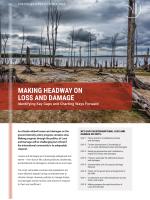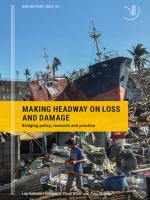Making headway on Loss and Damage
Losses and damages are increasingly widespread and severe – from loss of life, cultural practices, biodiversity, and livelihoods to damages to infrastructure and crops. The most vulnerable countries and populations are most affected, despite having contributed least to climate change. However, policies to manage losses and damages remain elusive, and actions to respond to them are insufficient.
Through analysis of policy, research and practice this policy brief points to key gaps and potential ways forward in Loss and Damage policy, to support policy solutions and action on the ground.
Loss and Damage policy development
Development of Loss and Damage as a policy space has been slow. An initial concept of Loss and Damage was elaborated in 1991, and the United Nations Framework Convention on Climate Change (UNFCCC) was established in 1992. However, Loss and Damage was first integrated into the Convention through the following developments:
- 2013: The Warsaw International Mechanism (WIM) for Loss and Damage was established
- 2015: The Paris Agreement was ratified, with Article 8 dealing directly with Loss and Damage
- 2019: The Santiago Network for technical assistance was established, though it is not yet fully operationalised
Recently, UNFCCC developments on Loss and Damage have taken shape on three unresolved fronts:
- Arrangements for funding relevant to loss and damage through the Glasgow Dialogue
- Fully operationalising a fit for purpose Santiago Network
- Governance arrangements for the Warsaw International Mechanism
The Intergovernmental Panel on Climate Change (IPCC) distinguishes between ‘Loss and Damage’ as a policy space, and ‘loss(es) and damage(s)’ on the ground.
The latter is defined as ‘harm from (observed) impacts and (projected) risks’ associated with anthropogenic climate change.
IPCC Assessment Report Six (2022) warns of current ‘widespread adverse impacts and related losses and damages to nature and people’.
IPCC reports document that climate risks are increasing more quickly than previously projected and that not all loss and damage can be minimised through adaptation. This points to the urgent need for additional policy attention to loss and damage.
These three issues are critical to ensuring that the UNFCCC can deliver solutions for frontline communities, yet there are clear sticking points, particularly on finance and governance. Overall, policy development has been impeded by divergent negotiating positions and understandings of Loss and Damage.
Charting ways forward
The following key gaps and ways forward have been identified through the study’s assessment of Loss and Damage policy, research and practice. Addressing these gaps will ensure major strides within Loss and Damage policy and action:
GAP 1: Policy attention to addressing losses
and damages
Losses and damages are already widespread. In addition to scaling-up efforts to adapt to and mitigate climate change, attention is therefore needed to address those losses and damages that neither have nor can be averted or minimised sufficiently, in line with the Paris Agreement’s recognition of the ‘importance of averting, minimizing and addressing’ loss and damage.
Potential ways forward include greater definitional clarity on Loss and Damage under the UNFCCC; increased focus on addressing losses and damages in current UNFCCC deliberations, e.g. financing mechanisms and technical assistance; and scaled-up action outside of the UNFCCC, though with agreement on the role of non UNFCCC actors in the longer term.
GAP 2: Further development of knowledge of un- or under-addressed losses and damages
Realities on the ground have outpaced projections and knowledge of the extent and severity of climate-related impacts and related losses and damages. This is especially true of specific types of losses and damages – related to slow-onset events, non-economic losses, and existential losses – which are especially un- or under addressed.
Potential ways forward include developing knowledge of under-addressed losses and damages, their implications within diverse communities and across ecological contexts, and assessment tools for the same. Learning from existing efforts to respond to losses and damages will also improve knowledge and responses. All of these will require inclusive forms of knowledge production to be effective. In addition, improved attribution science can enhance understandings of the relationship between climate change and losses and damages.
GAP 3: Designing approaches and modalities to respond to losses and damages
Because of the unprecedented nature and scope of losses and damages, new approaches to respond to losses and damages will be needed. In addition, attention to governance and decision-making processes of what constitutes loss and damage, e.g. who decides this and how at different levels, will be crucial for inclusive and equitable action.
Potential ways forward include localised approaches, linked to existing institutions and to international processes where relevant. Novel approaches will require forms of support with room for developing new methods (e.g. for attribution and assessment), as well as implementation of unproven methods, in high-risk conditions, and small-scale pilot projects, which can provide the basis for developing scaled-up or longer-term solutions.
GAP 4: Finance, especially for addressing losses and damages
Financial support is available, though insufficient, for averting and minimising loss and damage through mitigation and adaptation; finance for addressing loss and damage is highly limited and is increasingly becoming a matter of urgency. Evidence indicates that several gaps exist within the existing financial architecture if the full spectrum of losses and damages is to be addressed – currently, extensive loss and damage needs are going unfunded.
Nordic stakeholders* working with loss and damage point to:
- The importance of addressing losses and damages. While prevention through adaptation and mitigation is preferable, finance to addressing losses and damages is also necessary and should receive additional focus.
- Humanitarian actors have built up relevant experience, for example with direct cash transfers.
- For losses and damages that are difficult to quantify, the field of human rights can provide insights drawing on decades-long experience on human rights violations, including regarding ‘restitution, compensation and rehabilitation’.
Potential ways forward include further developing existing climate finance funds, e.g. establishing a new window in the Green Climate Fund (GCF) specifically for addressing loss and damage; a new financial facility/mechanism for addressing losses and damages; scaling up humanitarian assistance and bilateral assistance, especially in the short term; and harnessing innovative sources of finance such as carbon taxes and flight levies – all with particular attention to under-addressed forms of loss and damage.
GAP 5: Operationalise a fit for purpose Santiago Network
Parties need to agree on the institutional arrangements and the modalities for management of funds necessary to fully operationalise the Santiago Network. This will be critical to enabling the WIM to deliver on its third function: enhancing action and support, including finance, technology and capacity-building, to address loss and damage, to enable countries to undertake actions.
Ways forward include reaching consensus on the network’s structure – including governance arrangements (e.g. through an advisory body, the ExCom, or other arrangement); the secretariat/coordinating body, including a process to select a host organisation; and the network of members – with focus on a fit-for-purpose network that addresses the technical assistance needs and priorities of developing countries particularly vulnerable to climate change. Clarity is also needed on the funding arrangements for the Santiago Network.
GAP 6: Clarity on the governance arrangements of the WIM
The WIM is the only UNFCCC mechanism directly mandated to address loss and damage, yet its unresolved governance arrangements render its mandate unclear. Disagreement hinges on whether the WIM is now governed under the Paris Agreement – a stance taken by the US and some other developed countries – or whether there is dual governance of the WIM by both the Convention and the Paris Agreement.
Potential ways forward could be to adopt the governance arrangement best suited to the technical needs of the WIM. Irrespective of how this issue is resolved, it will be essential to ensure clarity in the delivery of the WIM’s mandates and to ensure those mandates are not diluted.
GAP 7: Coordination and institutionalisation across actors and scales
Averting, minimising and addressing losses and damages requires coordination across actors and scales (e.g. local, national, regional, global) as well as institutionalisation of measures across these scales.
Nordic stakeholders* working with loss and damage point to:
- The importance of a demand-driven approach that supports cooperation and avoids competition among actors.
- Lessons to be learned from the Climate Technology Centre and Network (CTCN), Risk- Informed Early Action Partnership (REAP), and the humanitarian-development-peace nexus generally.
- The need for a clear framing of the main aims of the network and an institutional anchoring that supports these.
Potential ways forward include developing national mechanisms to assess and address losses and damages linked to existing fields including adaptation, disaster risk reduction and development. Sub-nationally, efforts will need to reflect the diverse manifestations of loss and damage, ensure input from affected populations, and feed back up to national processes. In-country mechanisms should be linked to UNFCCC processes to integrate national efforts and needs into international climate policy and responses. This could be through Nationally Determined Contributions (NDCs) or possibly additional reporting as well as through the Global Stocktake.
GAP 8: Making progress through the politics of Loss and Damage
Many aspects of Loss and Damage are extremely politicised. It is important that there is room for diverging perspectives and to acknowledge the political nature of topics within the Loss and Damage policy area. Yet politicization can hinder progress on meeting needs in practice at a time when these needs are acute and growing. Concurrently, lack of progress in Loss and Damage may undermine other aspects of global climate action and negotiations.
Potential ways forward include scientific, needs-based approaches to Loss and Damage policy and possibly de-linking negotiating issues within Loss and Damage policy to allow for progress in some areas despite sticking points in others.
*Input from stakeholders was gathered at the stakeholder workshop 'Making headway on Loss and Damage: Bridging policy, research and practice' held in Copenhagen on September 28th, 2022, with participation of international NGOs and researchers as well as the Ministry of Foreign Affairs of Denmark.
This policy brief is part of the project ’Loss and Damage Associated with the Adverse Effects of Climate Change’ funded by Nordic Council of Ministers. All views are those of the authors alone. The brief is based on the DIIS-report ’Making Headway on Loss and Damage: Bridging policy, research and practice.’
DIIS Eksperter



